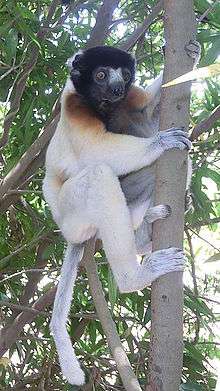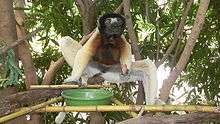Crowned sifaka
| Crowned sifaka | |
|---|---|
 | |
| Scientific classification | |
| Kingdom: | Animalia |
| Phylum: | Chordata |
| Class: | Mammalia |
| Order: | Primates |
| Suborder: | Strepsirrhini |
| Family: | Indriidae |
| Genus: | Propithecus |
| Species: | P. coronatus |
| Binomial name | |
| Propithecus coronatus Milne-Edwards, 1871[3] | |
 | |
| Distribution of P. coronatus[1] | |
| Synonyms | |
| |
The crowned sifaka (Propithecus coronatus) is a sifaka endemic to western Madagascar. It is of comparable size to the Golden-crowned sifaka and up to a meter in length, of which 47-57 centimeters are tail. The species is an arboreal vertical climber and leaper whose diet consists of leaves, fruits and flowers. It is threatened by habitat destruction and currently classified as Endangered by the IUCN.
Taxonomy
The crowned sifaka was formerly believed to be a subspecies of either Verreaux's sifaka or Von der Decken's sifaka, but is now considered a valid species following a 2007 analysis of the cranium.[4]
Description
The Crowned sifaka is a medium-sized sifaka who has a total length of 87 to 102 centimeters, of which 47-57 centimeters are tail, and 39.5 - 45.5 cm are the head and body. Males weigh 3.5-4.5 kg and 3.5-5.0 kg for females.[5] It is a sifaka of comparable size to the Golden-crowned sifaka, Von der Decken's sifaka and Verreaux's sifaka. The crowned sifaka is characterized by a creamy white body with tinges of golden brown around the shoulder region, upper chest and back with a dark chocolate or black head with white ear tufts. Their dark grey face is hairless and they have a white tail. Occasionally a pale patch across the bridge of the nose may be present. Crown sifaka color variations occur more commonly in the lower regions of the sifakas range between the Mahavavy and Manombolo rivers. Melanistic forms have been documented, with most occurrences observed where the southern limit of its range overlaps with that of P. deckenii.[6]
Distribution and habitat

The crowned sifaka is found in the mangroves and dry deciduous and riparian forests of northwest Madagascar.[6][7][8] Surveys have shown in the northern range of its habitat the crowned sifaka inhabits the forest between the Mahavavy River and Betsiboka River and extending south to the region of highly fragmented forests around the Tsiribihina River, Mahajilo River, and Mania River.[6] Total population size in 2014 was estimated as 4,000-36,000 individuals, at densities of 46-309 individuals/km2 in different-sized forest fragments, with an average group size of 2-8 individuals per group. Estimates remain uncertain since only part of the range has been surveyed so far. Total area of occupancy is thought to be 2,690-4,493 km2.[8]
Ecology
The crowned sifaka is a diurnal animal, primarily active during the day. It spends a majority of its time resting with the remainder mostly devoted to feeding.[9] It frequents the upper stories of large trees and often is found in tree crowns. Depending on season, it feeds on young or mature leaves, ripe and unripe fruits and great quantities of flowers.[1]
Group size is between 2 and 8 individuals and contains a balanced number of females and males in each group.[5] One dominant female is found in each group.[5][10] Social behavior within groups entails mostly allogrooming of other group members, agonistic behavior, and play as well as scent marking and call-localization.[10] Reproduction is seasonal, with gestation lasting 5–6 months and estrus lasting 4 months. Within the typical estrus period a female may have 3-5 estruses per reproductive season. Reproduction in the crowned sifaka has rarely been observed, and what little is known about it has been documented in the captive population at the Paris Zoological Park.[5]
Conservation
The very restricted range and fragmented populations of the crowned sifaka are major concerns for the continuation of this species. Habitat destruction, forest fragmentation, slash and burn agriculture, capture for illegal pet trade, and illegal hunting constitute major threats.[1][8] The species is currently listed by the IUCN Red List as Endangered. Some of the larger populations are found in protected areas, however much of its range remain relatively unexplored as they are labeled as politically “dangerous” zones. The 2009 Malagasy political crisis led to lawlessness across Madagascar and ultimately led to increased poaching of the sifaka for food as a delicacy in restaurants.[8] As of 2014 there is only one successful captive breeding population of crowned sifaka in the Paris Zoological Park in Paris, France.[5]
References
- 1 2 3 4 Andriaholinirina, N. et al. (2014). "Propithecus coronatus". IUCN Red List of Threatened Species. IUCN. 2014: e.T18356A16115921. Retrieved 10 March 2016.
- ↑ "Checklist of CITES Species". CITES. UNEP-WCMC. Retrieved 18 March 2015.
- ↑ Groves, C.P. (2005). Wilson, D.E.; Reeder, D.M., eds. Mammal Species of the World: A Taxonomic and Geographic Reference (3rd ed.). Baltimore: Johns Hopkins University Press. OCLC 62265494. ISBN 0-801-88221-4.
- ↑ Groves, Colin; Helgen, Kristofer (2006-11-01). "Craniodental Characters in the Taxonomy of Propithecus". Int J Primatol. 28: 1363–1383. doi:10.1007/s10764-007-9226-5.
- 1 2 3 4 5 Roullet, Delphine (2014). "The European Captive Population of Crowned Sifaka: 25 Years of Management". Primate Conservation: 99–107.
- 1 2 3 Andriamasimanana, Rado; Cameron, Alison (2014). "Spatio-Temporal Change in Crowned (Propithecus Coronatus) and Decken's Sifaka (Propithecus Deckenii) Habitat in the Mahavavy-Kinkony Wetland Complex, Madagascar". Primate Conservation. 28: 65–71.
- ↑ Garbutt, Nick (2007). Mammals of Madagascar, A Complete Guide. pp. 197–198.
- 1 2 3 4 Salomona, Jordi; Rasolondraibe, Emmanuel; Fabien, Jan; Besolo, Aubin; Rakotoarisoa, Heriniaina; Meyler, Sam Viana; Wolhauser, Sebastien; Rabarivola, Clement; Chikhi, Lounes (2014). "Conservation Status and Abundance of the Crowned Sifaka (Propithecus Coronatus)". Primate Conservation. 28: 73–83. Retrieved 2016-03-09.
- ↑ Pichon, Claire; Tarnaud, Laurent; Bayart, Francoise; Hiadik, Annette; Hiadik, Claudde Marcel; Simmen, Bruno (2010). "Feeding Ecology of the Crowned Sifaka (Propithecus Coronatus) in a Coastal Dry Forest in Northwest Madagascar (SUFM, Antrema)". Lemur News. 15: 43–47. Retrieved 2016-03-09.
- 1 2 Ramanamisata, Rivo; Pichon, Claire; Razafindraibe, Hanta; Simmen, Bruno (2014). "Social Behavior and Dominance of the Crowned Sifaka (Propithecus Coronatus) on Northwestern Madagascar". Primate Conservation. 28: 93–97. Retrieved 2016-03-09.
| Wikimedia Commons has media related to Propithecus coronatus. |
